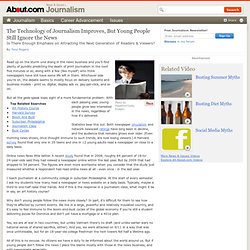

Embracing Three New Megatrends in the Brave New World of Digital Media. How Social Media is Replacing Traditional Journalism as a News Source [Infographic] Buffeted by the Web, but Now Riding It. It didn’t turn out that way.

If anything, digital technology has overwhelmed those who sought to master it. The Web may be a technological marvel, but to most people who use it for work, it functions like an old-fashioned hamster wheel, except at Internet speed. Brian Lam was both a prince and a casualty of that realm. After interning at Wired, he became the editor of Gizmodo, ’s gadget blog. A trained Thai boxer, he focused his aggression on cranking out enough copy to increase the site’s traffic, to a peak of 180 million page views from 13 million in the five years he was there. How many journalists are enough? Young People and News Consumption - The Technology of Journalism Improves, But Young People Still Ignore the News.
Read up on the sturm und drang in the news business and you'll find plenty of pundits predicting the death of print journalism in the next five minutes or so, along with a few (like myself) who think newspapers have still have some life left in them.

Whichever side you're on, the debate seems to mostly focus on delivery systems and business models - print vs. digital, display ads vs. pay-per-click, and so on. But all the geek-speak loses sight of a more fundamental problem: With each passing year, young people grow less interested in the news, regardless of how it's delivered. Statistics bear this out. Both newspaper circulation and network newscast ratings have long been in decline, and the audience that remains grows ever older.